
Safety at work is a paramount priority. Though we may sometimes grumble at regulations, the fact is that safety at work is now far superior to what it was like 50 or even 20 years ago, and this is a very good thing. Lifting equipment presents very obvious hazards and therefore we must take great care to ensure it is safe to use and that operators are fully trained and safety conscious. Sticking to the recommended service and inspection frequencies is only a matter of sheer common sense.

Summary & The Legal Framework
All of the activities required by the various pieces of legislation come under the Health and Safety at Work etc. Act 1974. Lifting equipment is subject to LOLER regulations, which specifies a program of regular inspections and “thorough examinations by a competent person”.
All equipment used in the work environment must be maintained so as be safe to use. Not to do so is both a hazard and a breach of basic H&S law. LOLER does not specify crane service frequencies because that is down to each manufacturer to determine, for each model it supplies.
These are the recommended minimum frequencies:
- Equipment used to lift people should be inspected every 6 months at a minimum
- Equipment used to lift goods only should be inspected every 12 months at a minimum
Maintenance Service Checks should be carried out as recommended by the manufacturer. Generally, manufacturers recommend 12 month service intervals. Most HIAB products come with a service manual that details the various intervals and itemizes the checks and/or replacements that should be performed at each service point. Many user manuals are downloadable should the original be misplaced.
LOLER
The relevant Health and Safety legislation for HIAB equipment is LOLER - Lifting Operations and Lifting Equipment Regulations 1998. It covers both maintenance and operation to ensure the highest safety standards at all times. With any machines such as HIABS, where loads are lifted off the ground and transferred from one location to another, safety is paramount. Not only must the machinery be in good working order, the load must be with its Safe Working Load (SWL) tolerances and the operator must be properly trained both in how to use the equipment and how to do it safely.
LOLER places the onus on employers to implement the regulations. That is, owners of HIAB machinery or anybody who has leased or hired it. That is in contrast to the operators, who are hired by the owners.
Inspections
It makes sense to perform frequent visual inspections of lifting equipment to detect any obvious defects or breakdowns. LOLER reinforces that and also lays down a mandatory program of professional inspections and maintenance intervals. These are not onerous and are not much more than car owners do for their vehicles.
LOLER calls inspections “thorough examinations” and refers to what it calls a “competent person”. That is “someone with the necessary skills, knowledge and experience” in the equipment and the regulations. Someone with that level of competence should prepare the schedule of inspections/examinations and maintenance, and carry out the mandatory thorough examinations.
Consult The Professionals
Truck Loaders are experts in maintaining, servicing and inspecting all lifting equipment. Under one of our service programs, you can rest assured that every legal requirement relating to inspections and crane service frequency will be taken care of as a matter of course. Call for more information on 0330 999 0003 or email service@truckloaders.co.uk
